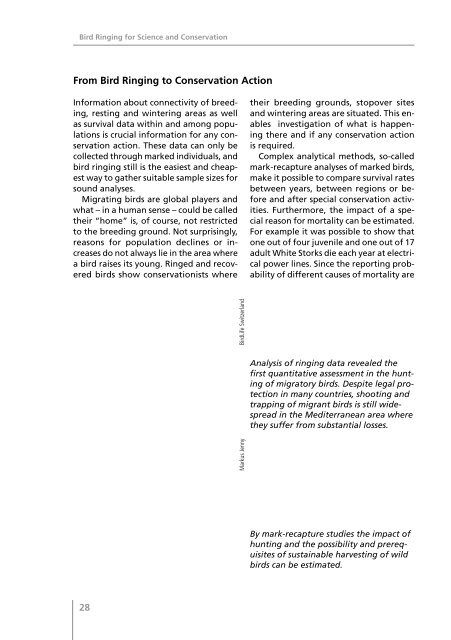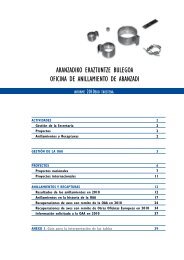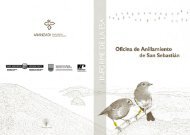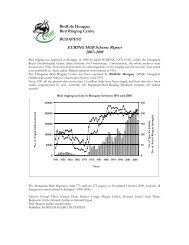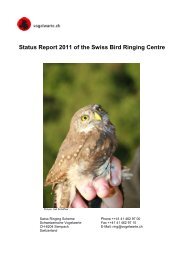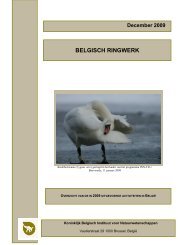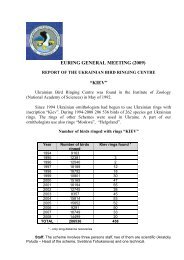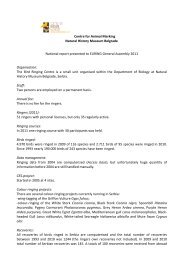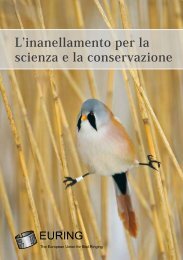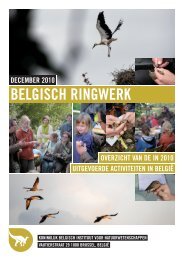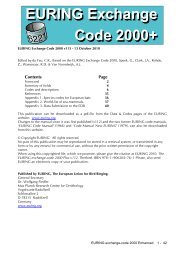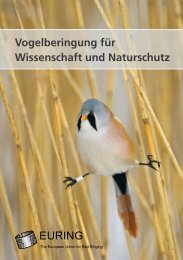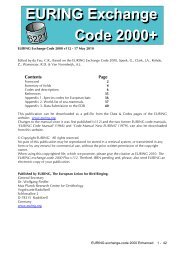Bird Ringing for Science and Conservation - The European Union ...
Bird Ringing for Science and Conservation - The European Union ...
Bird Ringing for Science and Conservation - The European Union ...
- No tags were found...
Create successful ePaper yourself
Turn your PDF publications into a flip-book with our unique Google optimized e-Paper software.
<strong>Bird</strong> <strong>Ringing</strong> <strong>for</strong> <strong>Science</strong> <strong>and</strong> <strong>Conservation</strong><br />
<strong>Bird</strong> <strong>Ringing</strong> <strong>for</strong> <strong>Science</strong> <strong>and</strong> <strong>Conservation</strong><br />
From <strong>Bird</strong> <strong>Ringing</strong> to <strong>Conservation</strong> Action<br />
In<strong>for</strong>mation about connectivity of breeding,<br />
resting <strong>and</strong> wintering areas as well<br />
as survival data within <strong>and</strong> among populations<br />
is crucial in<strong>for</strong>mation <strong>for</strong> any conservation<br />
action. <strong>The</strong>se data can only be<br />
collected through marked individuals, <strong>and</strong><br />
bird ringing still is the easiest <strong>and</strong> cheapest<br />
way to gather suitable sample sizes <strong>for</strong><br />
sound analyses.<br />
Migrating birds are global players <strong>and</strong><br />
what – in a human sense – could be called<br />
their “home” is, of course, not restricted<br />
to the breeding ground. Not surprisingly,<br />
reasons <strong>for</strong> population declines or increases<br />
do not always lie in the area where<br />
a bird raises its young. Ringed <strong>and</strong> recovered<br />
birds show conservationists where<br />
<strong>Bird</strong>Life Switzerl<strong>and</strong><br />
Markus Jenny<br />
their breeding grounds, stopover sites<br />
<strong>and</strong> wintering areas are situated. This enables<br />
investigation of what is happening<br />
there <strong>and</strong> if any conservation action<br />
is required.<br />
Complex analytical methods, so-called<br />
mark-recapture analyses of marked birds,<br />
make it possible to compare survival rates<br />
between years, between regions or be<strong>for</strong>e<br />
<strong>and</strong> after special conservation activities.<br />
Furthermore, the impact of a special<br />
reason <strong>for</strong> mortality can be estimated.<br />
For example it was possible to show that<br />
one out of four juvenile <strong>and</strong> one out of 17<br />
adult White Storks die each year at electrical<br />
power lines. Since the reporting probability<br />
of different causes of mortality are<br />
Analysis of ringing data revealed the<br />
first quantitative assessment in the hunting<br />
of migratory birds. Despite legal protection<br />
in many countries, shooting <strong>and</strong><br />
trapping of migrant birds is still widespread<br />
in the Mediterranean area where<br />
they suffer from substantial losses.<br />
By mark-recapture studies the impact of<br />
hunting <strong>and</strong> the possibility <strong>and</strong> prerequisites<br />
of sustainable harvesting of wild<br />
birds can be estimated.<br />
International Conventions requiring bird populations to be monitored<br />
• EC Directive on the <strong>Conservation</strong> of Wild <strong>Bird</strong>s (1979/409/EEC) (Articles 4, 6, 7 <strong>and</strong> 10)<br />
• Ramsar Convention on Wetl<strong>and</strong>s of International Importance especially as Waterfowl<br />
Habitat (1976) (Articles 2 <strong>and</strong> 4)<br />
• Bern Convention on the <strong>Conservation</strong> of <strong>European</strong> Wildlife <strong>and</strong> Natural Habitats<br />
(1979) (Articles 1-4,10 <strong>and</strong> 11)<br />
• Bonn Convention on the <strong>Conservation</strong> of Migratory Species of Wild Animals (1980)<br />
(Articles 2 <strong>and</strong> 5)<br />
• AEWA Action Plan to the Bonn Convention (1999)<br />
• <strong>European</strong> Water Framework Directive 2000/60/EG (2000) (Article 6 <strong>and</strong> Appendix IV<br />
<strong>and</strong> V).<br />
different, these models based on ringed<br />
<strong>and</strong> recovered individuals provide much<br />
more reliable in<strong>for</strong>mation than any simple<br />
count of cases. It is also possible to<br />
test if a distinct reason of mortality might<br />
be offset by other reasons, thus reducing<br />
the overall effect on a population. Such<br />
analyses provide conservationists with in<strong>for</strong>mation<br />
about the crucial issues to address<br />
<strong>and</strong> enable them to evaluate conservation<br />
ef<strong>for</strong>t.<br />
Recoveries of birds reported as shot during<br />
hunting activity are of the utmost importance<br />
<strong>for</strong> the proper management of<br />
the populations of game birds. Reports<br />
of shot ringed birds are used in mark-recapture<br />
analyses to answer the question<br />
of whether hunting mortality is additive<br />
or compensatory to natural mortality <strong>and</strong><br />
what level of harvesting of wild birds of<br />
a distinct population is sustainable. Geographical<br />
variation in the average survival<br />
rates of Robin <strong>and</strong> Song Thrush was<br />
correlated with the hunting pressure experienced<br />
by those populations. This suggests<br />
that, <strong>for</strong> these two species, hunting<br />
causes mortality that is additional to natural<br />
mortality.<br />
Monitoring of bird populations as required<br />
by several international conventions<br />
is a prerequisite <strong>for</strong> effective protective<br />
measurements <strong>for</strong> the many declining<br />
bird species. However, counting heads<br />
does not provide in<strong>for</strong>mation about the<br />
reasons <strong>for</strong> population changes since it<br />
does not account <strong>for</strong> survival rates, age<br />
structure, longevity or productivity in the<br />
populations. EURING holds the only longterm<br />
data set covering most bird species<br />
which can be used to study a whole range<br />
of crucial population characteristics. <strong>The</strong><br />
potential <strong>for</strong> further co-ordinated <strong>European</strong>-wide<br />
bird ringing research is immense.<br />
EURING <strong>and</strong> the National <strong>Ringing</strong><br />
Schemes have the potential to co-ordinate<br />
large numbers of amateur ringers <strong>for</strong> such<br />
projects (see page 17).<br />
Recently, the African winter quarter of the<br />
highly endangerd Aquatic Warbler has<br />
been discovered in the Senegal delta area.<br />
Martin Flade / <strong>Bird</strong>Life International<br />
28<br />
29


